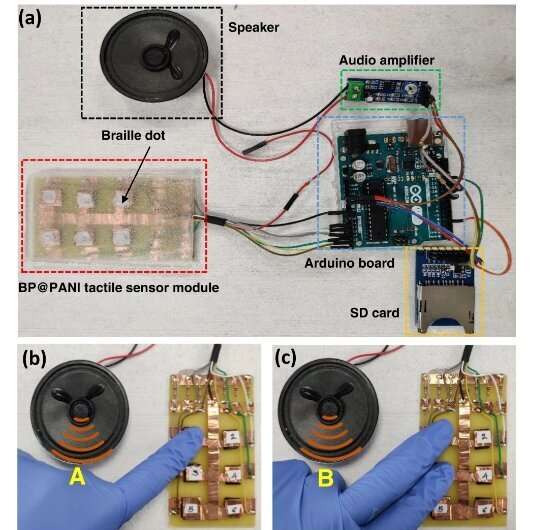Black phosphorus–based human–machine communication interface: A breakthrough in assistive technology

Researchers at the University of Chemistry and Technology in Prague have made progress in the field of assistive technology with the development of a novel auditory human–machine interface using black phosphorus–based tactile sensors. Research led by Prof. Martin Pumera and Dr. Jan Vyskočil has the potential to revolutionize communication for visually or speech-disabled individuals by providing an intuitive and efficient means of conveying information.
Assistive technology that utilizes auditory feedback has traditionally been employed by individuals with visual impairments or speech and language difficulties. In this study, the focus was on creating an auditory human-machine interface that utilizes audio as a platform for communication between disabled users and society. The researchers developed a piezoresistive tactile sensor using a composite of black phosphorus and polyaniline (BP@PANI) through a simple chemical oxidative polymerization process on cotton fabric.
The unique structure and superior electrical properties of black phosphorus, combined with the large surface area of the fabric, enabled the BP@PANI-based tactile sensor to exhibit exceptional sensitivity, low-pressure sensitivity, reasonable response time, and excellent cycle stability. To demonstrate the real-world application, a prototype device was created, incorporating six BP@PANI tactile sensors corresponding to braille characters. This device can convert pressed text into audio, aiding visually or speech-disabled individuals in reading and typing. It offers a promising solution for improving communication and accessibility for this demographic.
Prof. Martin Pumera, the lead researcher, explains the significance of this research: “Our study provides valuable insights into the development of auditory feedback devices based on layered and 2D materials for human–machine interfaces. By utilizing black phosphorus as the active material, we have achieved remarkable sensitivity and stability in our tactile sensor. This opens up new possibilities for low-cost tactile sensors that can be seamlessly integrated into wearable electronics, such as human–machine communication interfacing and touch screens.”
Dr. Jan Vyskočil, the co-author of the study, emphasizes the practical implications: “The tactile sensor we have developed has the potential to greatly enhance the lives of visually or speech-disabled individuals. With the ability to convert braille characters into audio, this technology facilitates the learning and reading of braille letters, thus improving communication abilities. Furthermore, it can be applied to create portable electronic books, providing a versatile tool for education and accessibility.”
This research represents a significant step forward in the field of assistive technology, offering a novel approach to auditory human–machine interfaces. The use of black phosphorus–based tactile sensors showcases the potential of layered and 2D materials in the development of highly sensitive and stable devices. The scalable and cost-effective fabrication process of the proposed technology further enhances its potential for widespread integration in future wearable electronics.
The study is published in the journal Nature Communications.
More information:
Jayraj V. Vaghasiya et al, Black phosphorous-based human-machine communication interface, Nature Communications (2023). DOI: 10.1038/s41467-022-34482-4
Citation:
Black phosphorus–based human–machine communication interface: A breakthrough in assistive technology (2023, June 13)
retrieved 13 June 2023
from https://techxplore.com/news/2023-06-black-phosphorusbased-humanmachine-communication-interface.html
This document is subject to copyright. Apart from any fair dealing for the purpose of private study or research, no
part may be reproduced without the written permission. The content is provided for information purposes only.
For all the latest Technology News Click Here
For the latest news and updates, follow us on Google News.
